(MENAFN- USA Art News) They were known as the“three witches.”
In the feverish cultural milieu of 1930s Mexico City, artists Leonora Carrington, Remedios Varo, and Kati Horna were the closest of friends and frequent artistic collaborators. Each a European expatriate-Carrington from England, Varo from Spain, and Horna from Hungary-these women came to Mexico fleeing war and persecution and found in each other kindred spirits with shared interests in witchcraft, alchemy, and tarot, passions which bled into their uncanny artworks and collaborative visions.
Still, history has remembered their legacies unevenly. While in recent years, Carrington and Varo have become familiar names amid reexaminations of women's role in Surrealism's development, Horna, however, has remained a surprisingly obscure figure.
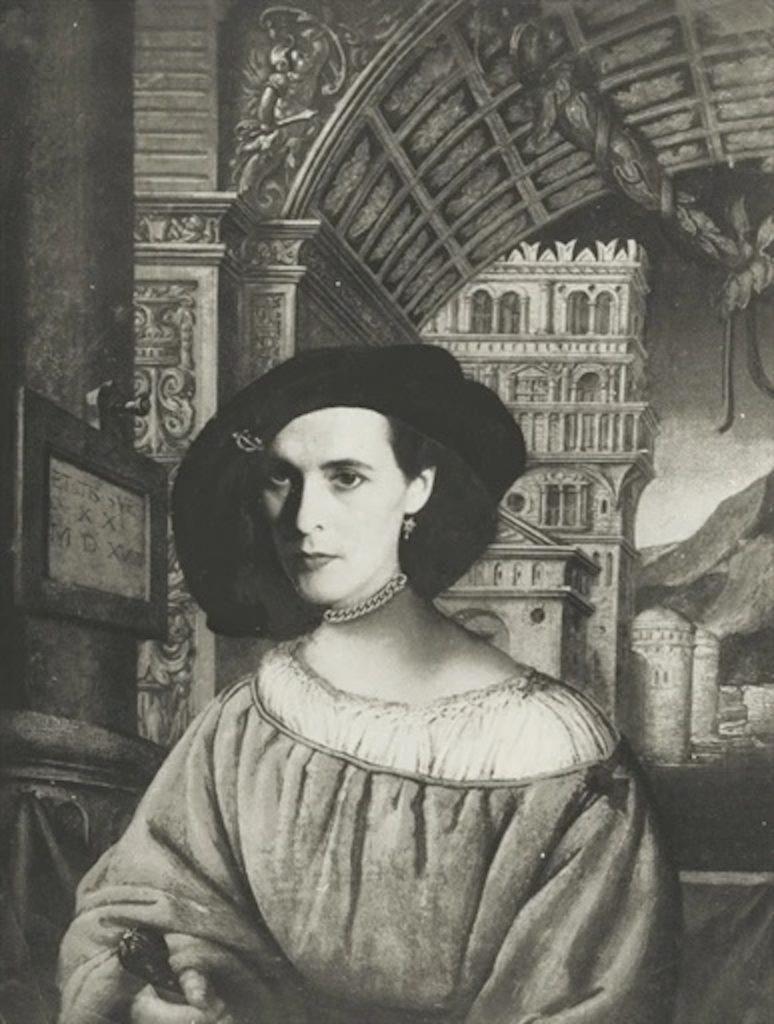
Kati Horna, Portrait of Leonora Carrington (1960/1987). Courtesy of Ruiz-Healy Art.
But her strange and beautiful photography may now be drawing new light. New York's Ruiz-Healy Art is currently presenting“kati horna: in motion”-the first devoted exhibition of Horna's work in the city. This haunting exhibition brings together photographs made from the 1930s into the 1960s and offers a window into Horna's internal world-one replete with mysticism and loss shaped by a war-torn life.
Horna was born Katalin Deutsch in Budapest in 1919 to an upper-class Jewish family (Horna would marry the artist Jose Horna in Paris in the late 1930s). She lived amid city's the intelligentsia and was a childhood friend of Robert Capa, studying photography alongside him. As a teenager, she apprenticed herself to the celebrated photographer József Pesci, whose avant-garde imagery bridged advertising and Constructivist aesthetics.
By her twenties, Horna had moved to Berlin, befriending Bertolt Brecht, Walter Benjamin, and her compatriot László Moholy-Nagy. The turbulence of the era pulled her throughout the continent. In 1933, she went to Paris, enmeshing herself in the Surrealist movement. A leftist driven by her politics and a supporter of the Spanish Republican cause, she soon relocated to Spain, working as a war photographer through the Spanish Civil War, linking for a time with Capa. These photojournalistic images were published widely, particularly in the (New York's Americas Society presented a curation of these works in 2016), and while the exhibition at Ruiz-Healy focuses primarily on Horna's artistic pursuits made in Mexico, dealer Patricia Ruiz-Healy says her photojournalism-and experiences of war-as key to understanding her oeuvre.
“Kati's photojournalism gave her economic independence and the ability to pursue her political beliefs. Her father died when she was 18 or 19 and she invested an inheritance from her father in buying a camera and for photography classes,” said Patricia Ruiz-Healy, in a conversation,“It gave her creative freedom.”
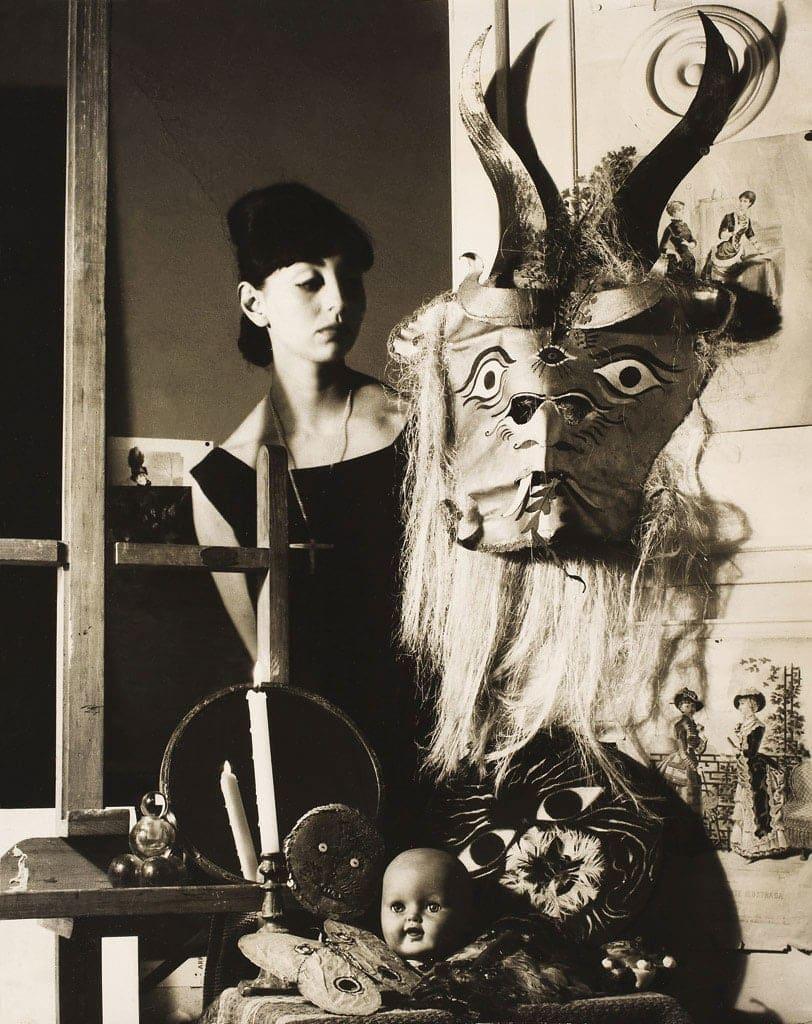
Kati Horna, Mujer Con Máscara (1961) from the series“Mujer Y Máscara.” Courtesy of Ruiz-Healy Art.
Returning to Paris in 1938, Horna and her husband would be pushed into flight again the following year as France came under Nazi occupation. This final exodus would bring the artist to Mexico, a country she would grow to love deeply, and which would allow her the refuge for artistic experimentation.“I am allergic to the question of where I am from,” Horna wrote.“I fled Hungary, I fled Berlin, I fled Paris, and I left everything behind in Barcelona...When Barcelona fell, I couldn't go back for my things, I lost everything again. I got to a fifth country, Mexico, with my Rolleiflex around my neck, and nothing else.”
In these Mexican-era photographs, one notices certain recurring fascinations: dolls and masks, Surrealist and occult imagery, and the lives of her friends. Again and again, Leonora Carrington and Remedios Varo appear captured in time, as do other artists and actors of the time, in imagery both staged and candid. Varo leans against a window sill, smoking a cigarette, in one photograph, captured as though midstream in conversation. In another, Carrington paints at her easel, with relaxed familiarity.
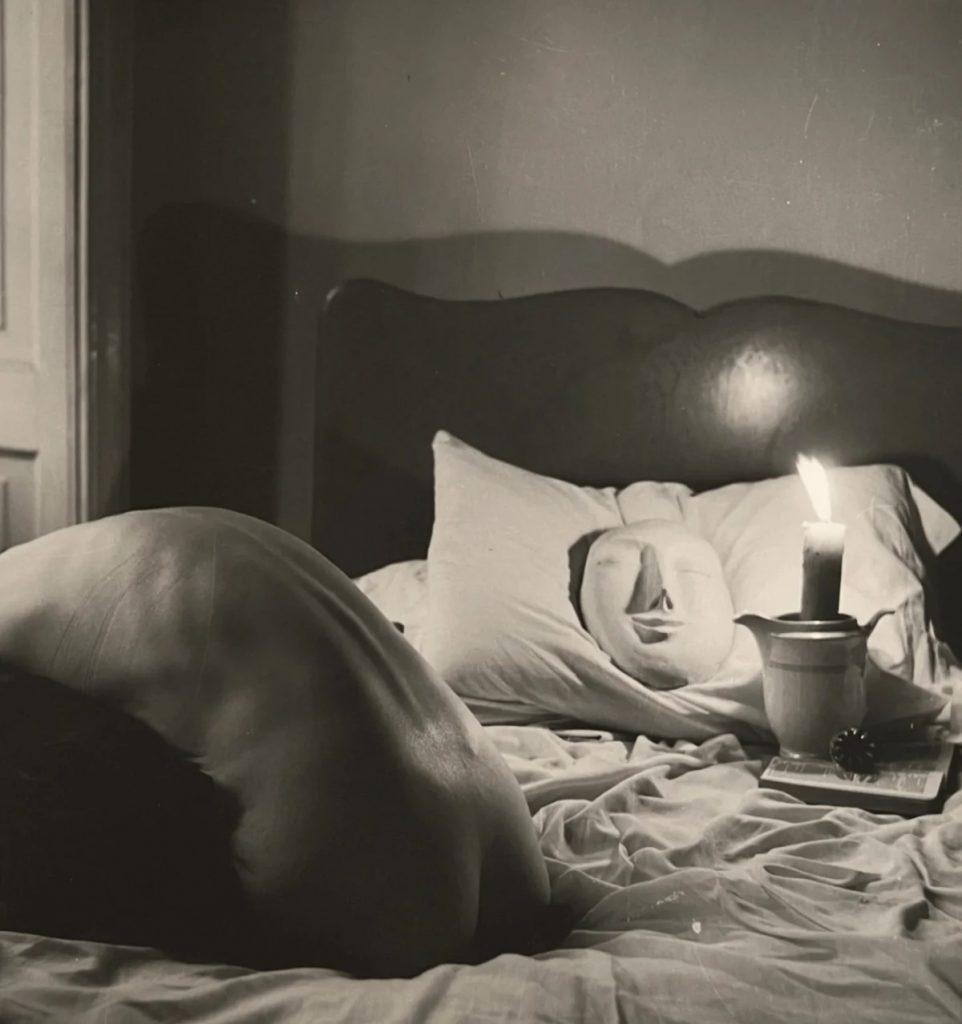
Kati Horna, Leonora from the series“Oda A La Necrofilia” (Ode To Necrophilia) (1962). Courtesy of Ruiz-Healy Art.
“Kati captures Carrington and Varo in their more intimate settings. They appear so relaxed-painting, working, socializing. These are often images of good times, fun times, which are all the more striking when we know how much these people had all suffered in their lifetimes,” said Ruiz-Healy.“So much.” Other photographs are materially and technically experimental, and the show includes photomontages and photo-collages. In keeping with Horna's Surrealist inclinations. In one photograph, actress Beatriz Sheridan presses her face against a mirror, appearing like a beheaded saint or Medusa, proffering, it seems, her peculiar reflection. In another, an unidentified model is photographed through a glass jug, creating a rippling effect on the photograph's flat surface. Carrington, particularly, appears often as Horna's model and muse, her face photo-collaged, in one image, into a Di Chirico-esque architectural space. Varo and Carrington also appear obliquely, in masks and other objects made by the artists (in one of Horna's photographs, Carrington is pictured in a mask made by Varo, encapsulating their artistic trinity).
Masks are one of Horna's most enduring symbols. In a marvelously uncanny series,“Ode to Necrophilia”-which Horna made for the avant-garde magazine S.NOB in 1962-Carrington appears nude, sitting and crouched beside a rumpled bed. In what seems a twilight light, her face turns away from the viewer, on the pillow rests a haunting white mask.
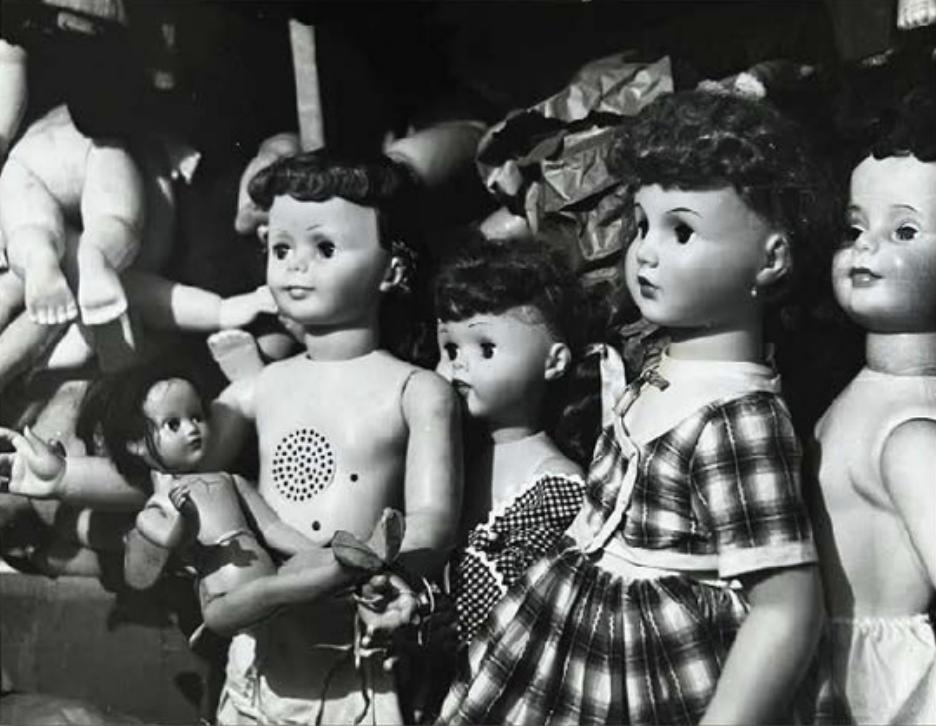
Kati Horna, Untitled (1933/1960) from the series“Marchés Aux Puces, Paris.” Courtesy of Ruiz-Healy Art.
“These are death masks” explained Patti Ruiz-Healy, daughter of gallery founder Patricia and director of the New York space.“Often a plaster cast would be made from the face of a loved one when they died.”
The images are unexpectedly serene.“These photographs were made in the early 1960s, at a time when Kati's husband Jose was very sick, and soon passed away. Remedios, who was like a sister to her, was also very sick and died in 1963. It was a way for Kati and Leonora to mourn these people in their lives,” said Patricia Ruiz-Healy. The 'Necrophilia' of the title here alludes to the physical love, longing, and embodied mourning for loved ones who are dying or who have passed on.
Death suffuses all hidden corners of her oeuvre, it seems, and Horna's perhaps most revealing images are absent of living figures altogether, instead depicting jumbles of broken dolls in stark black-and-white images. The 1962 series“A Night at the Doll Hospital” focuses entirely on such images, and while superficially these images might call to mind the darkly Surrealist photographs of Hans Bellmer, upon closer consideration Horna's series is a more tender contemplation of innocence and its loss.
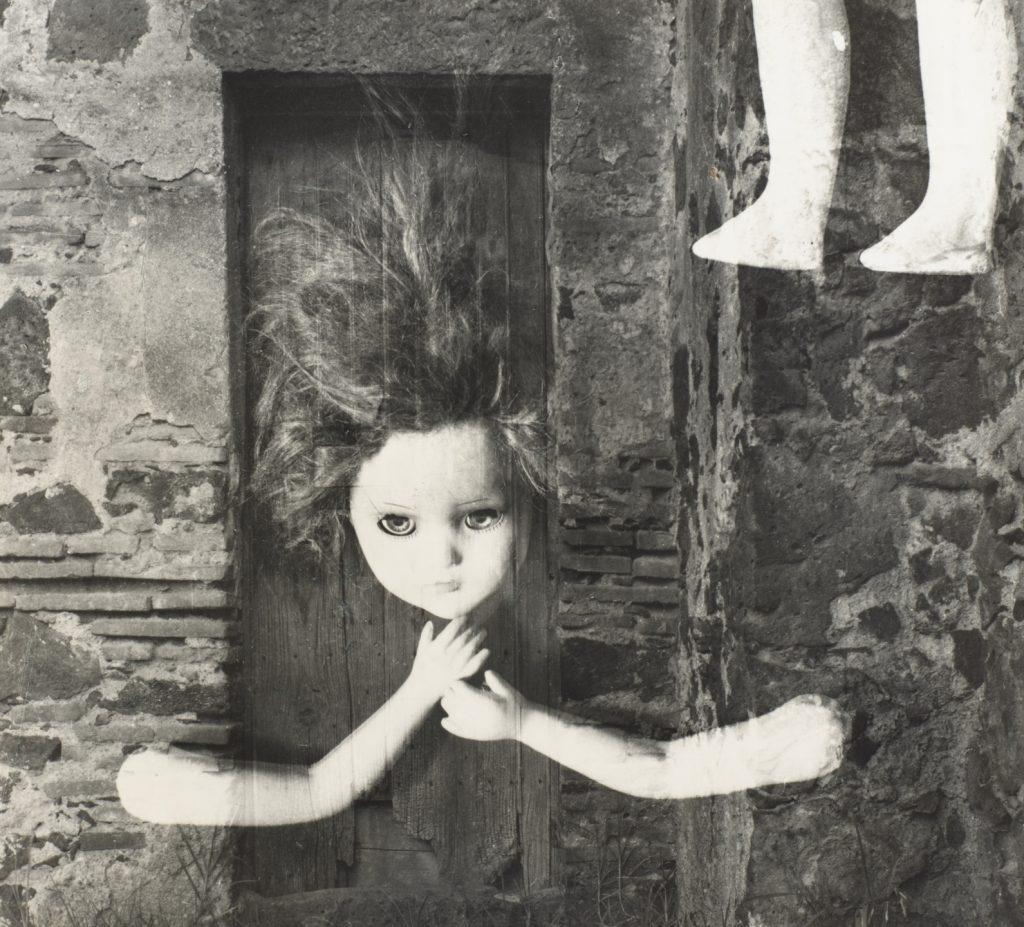
Kati Horna, Untitled (1962) from the series“Una Noche en el Sanatorio De Muñecas” (A Night at the Doll Hospital). Courtesy of Ruiz-Healy Art.
“What she saw in Spain stayed with her forever. She would go into towns and see women and children laying dead in the street with baby dolls and discarded toys next to them,” said Patricia Ruiz-Healy,“The dolls are very symbolic for her. In the series 'The Night at the Doll Hospital' there is some hope of fixing them.”
Horna lived in Mexico until her death in 2000 and continued making work late into life. Patricia and Patti Ruiz-Healy believe some of Horna's obscurity is due to the rarity of her work in the market. The dealers were introduced to Horna's daughter, Leonora (named after Carrington), who manages her mother's estate along with her children, but an exhibition took years to mount.“Horna made only a select reprint of her vintage prints in the 1960s, and donated much of her archive to the Spanish government and to a research institute in Mexico City,” said Patti Ruiz-Healy. Nevertheless, her reputation has been growing steadily in institutional circles. Her works were included in the Metropolitan Museum of Art's exhibition“Beyond Surrealism” in 2021. When asked what Horna would have thought of the prospect of art fame, the dealers were circumspect, given Horna's politics.“She considered herself an art worker, not an artist,” noted Patricia Ruiz-Healy.